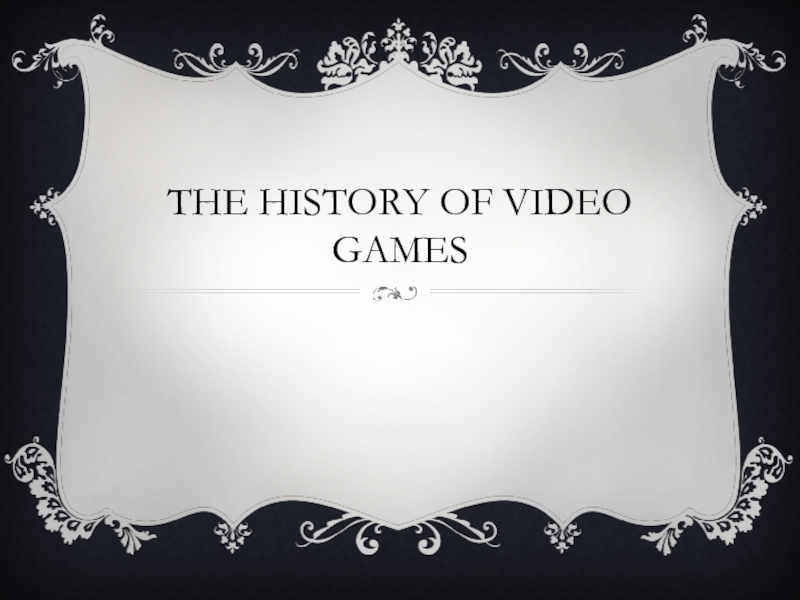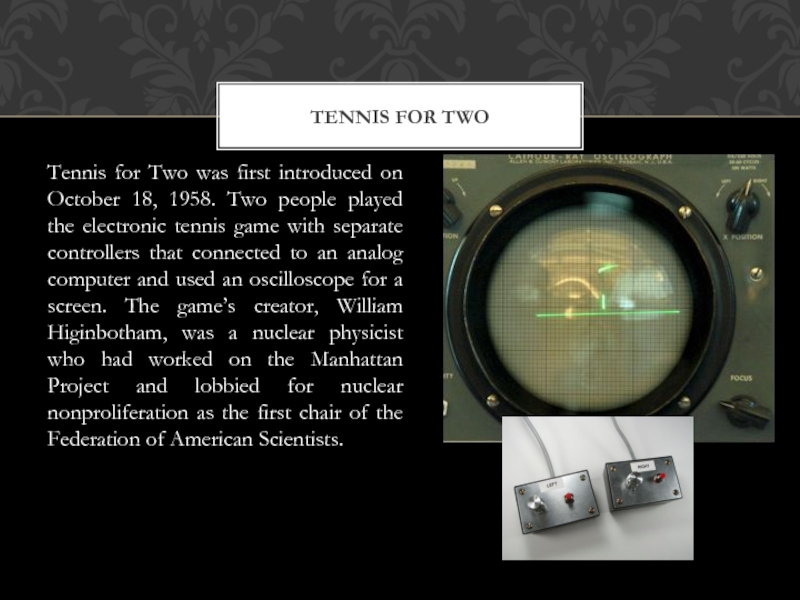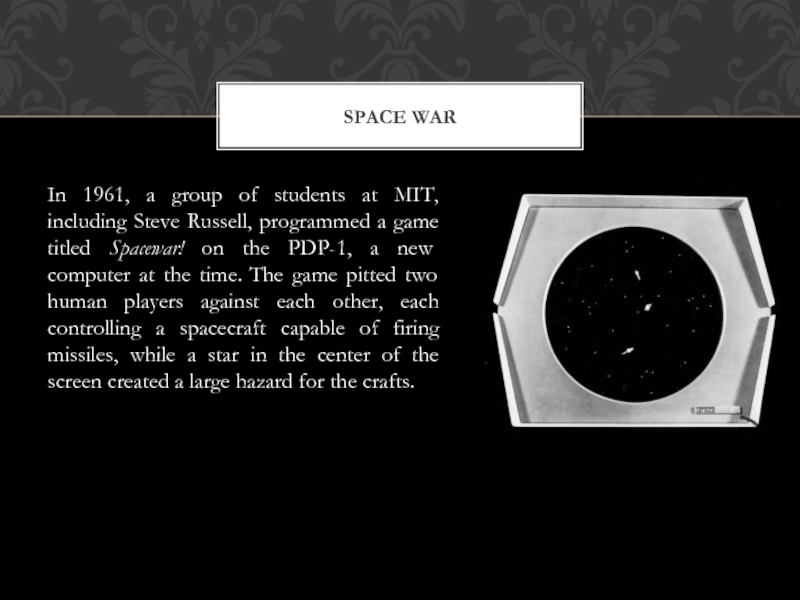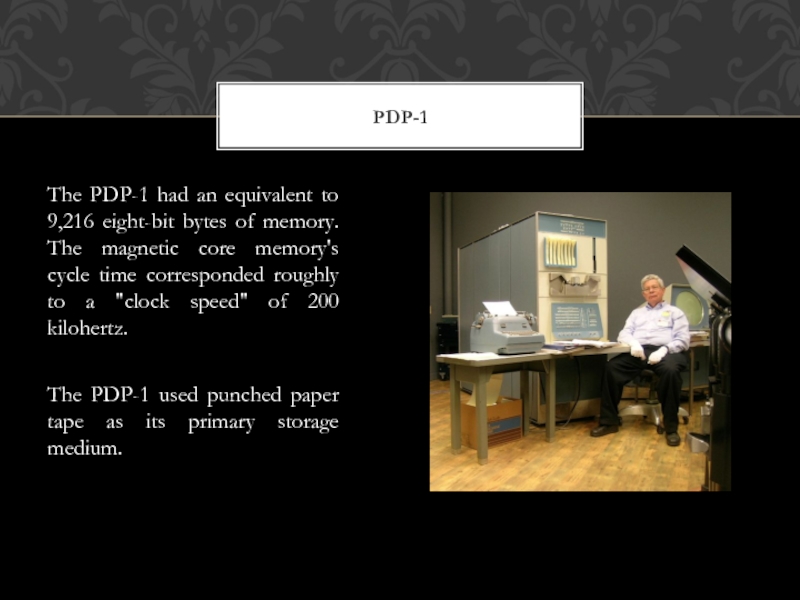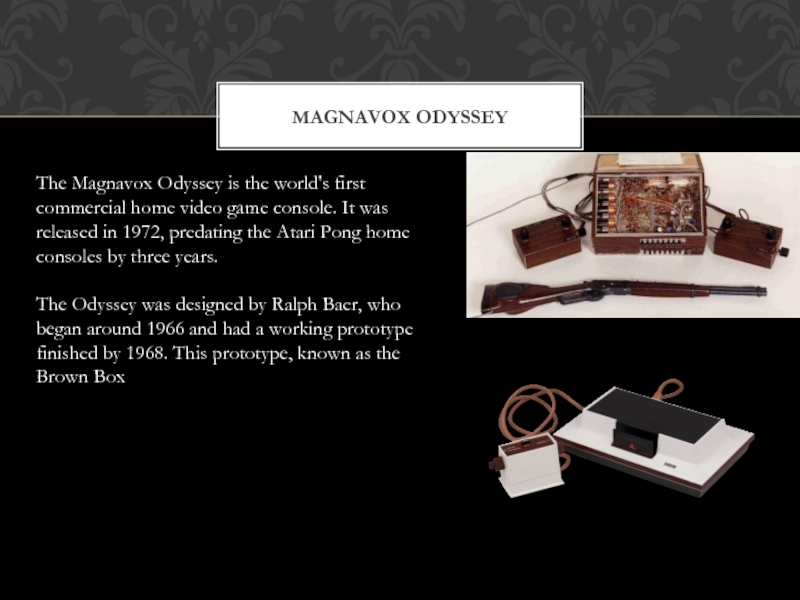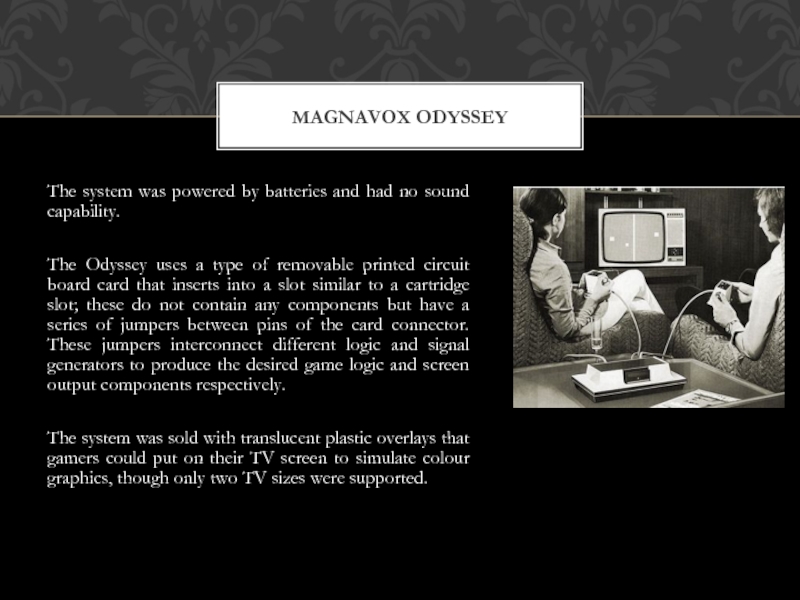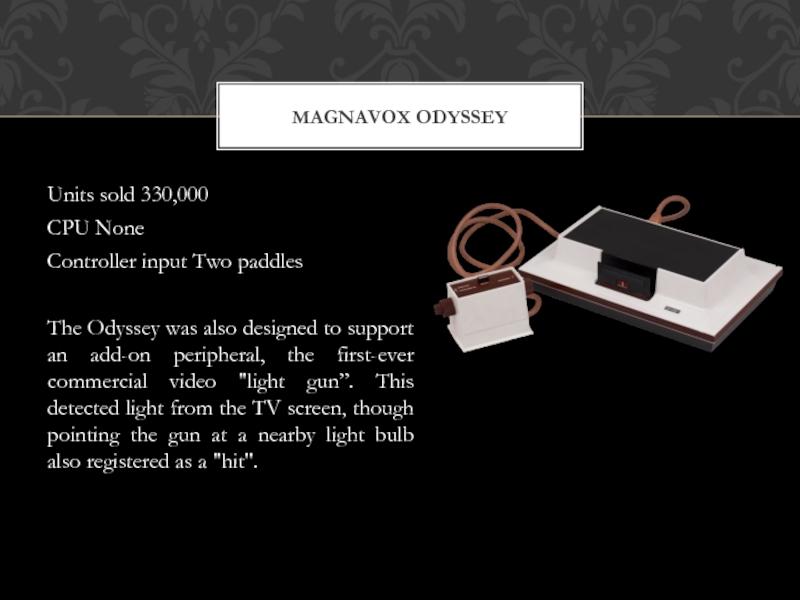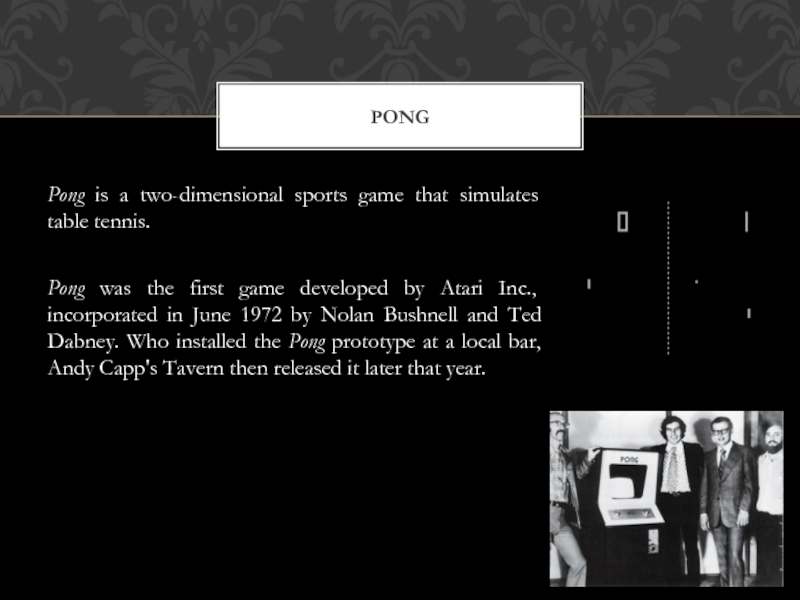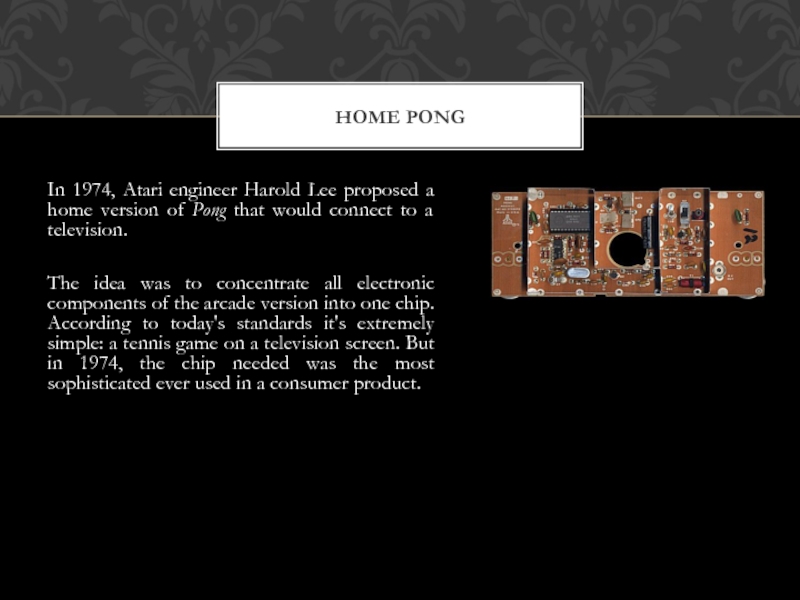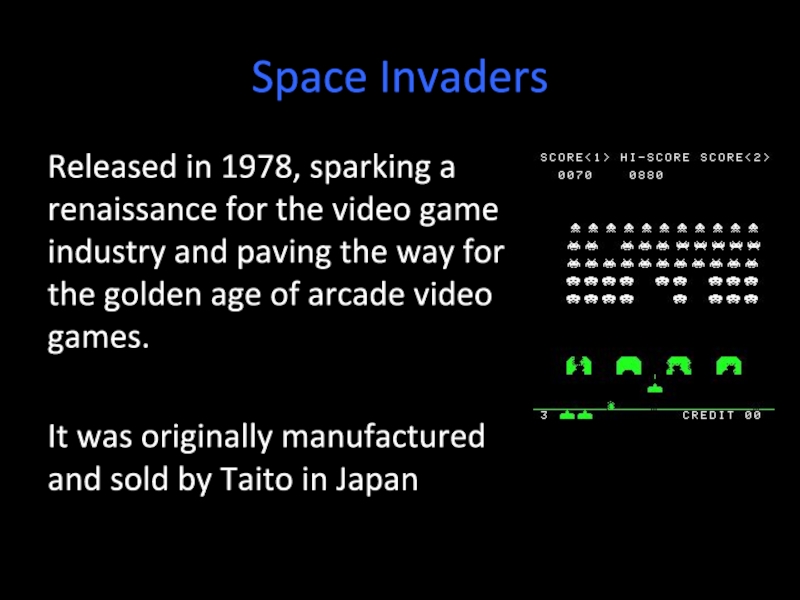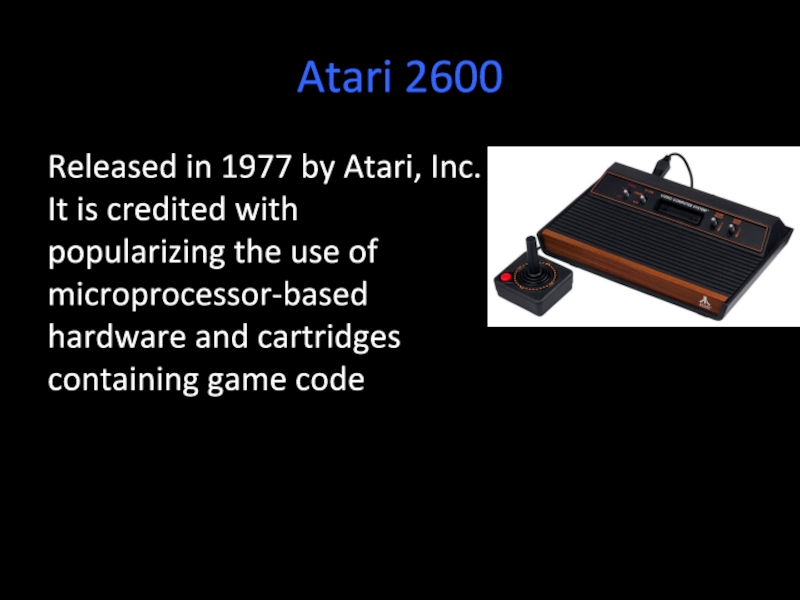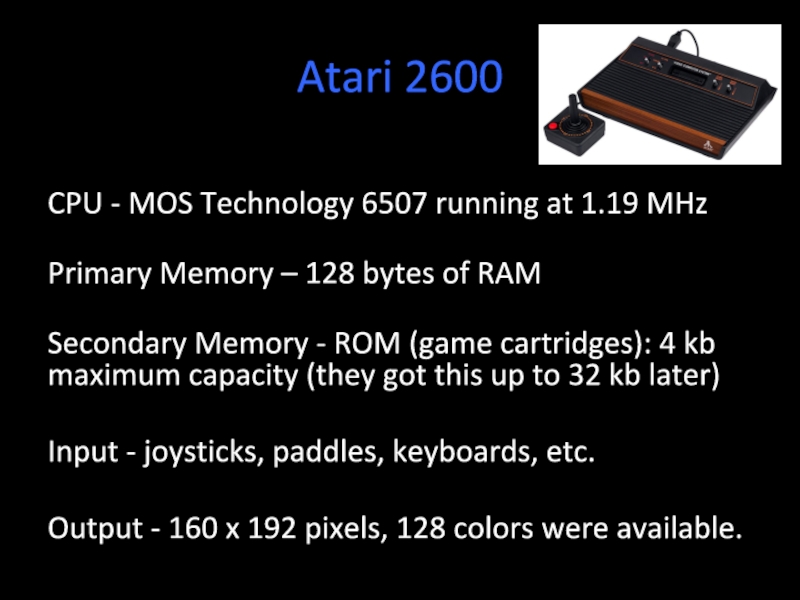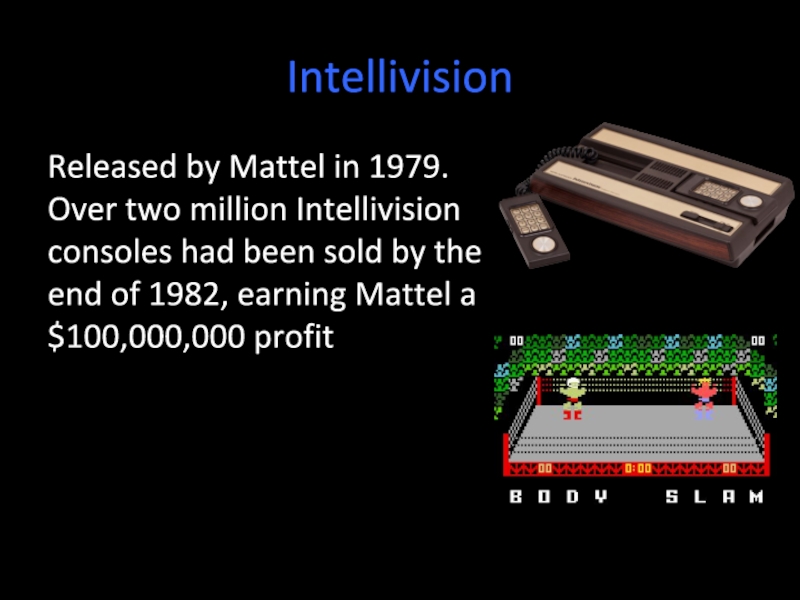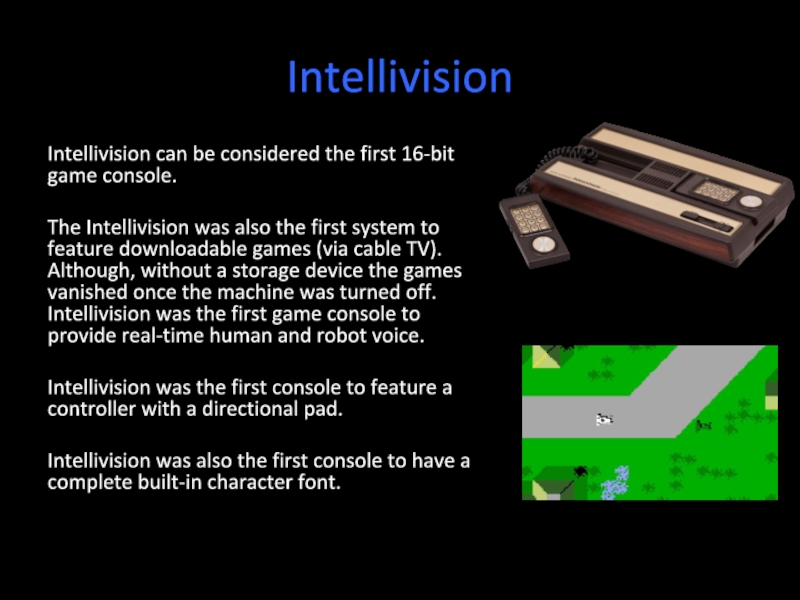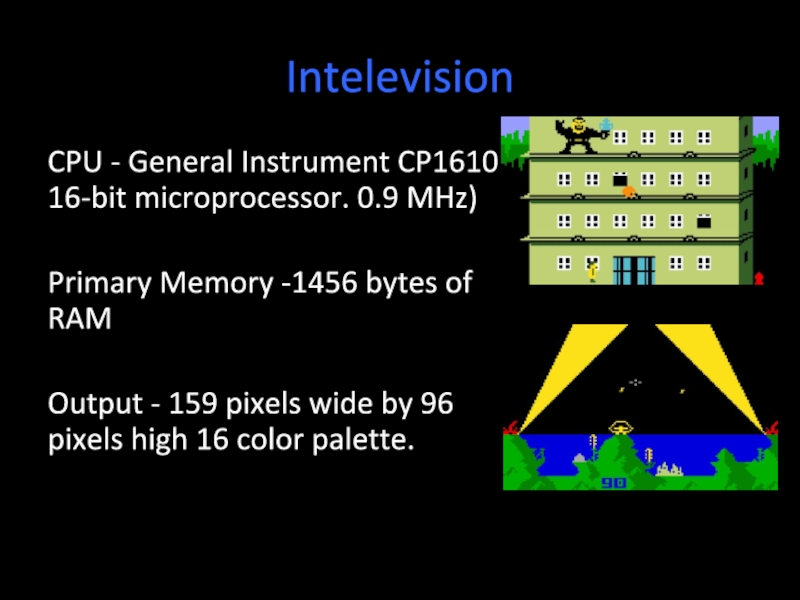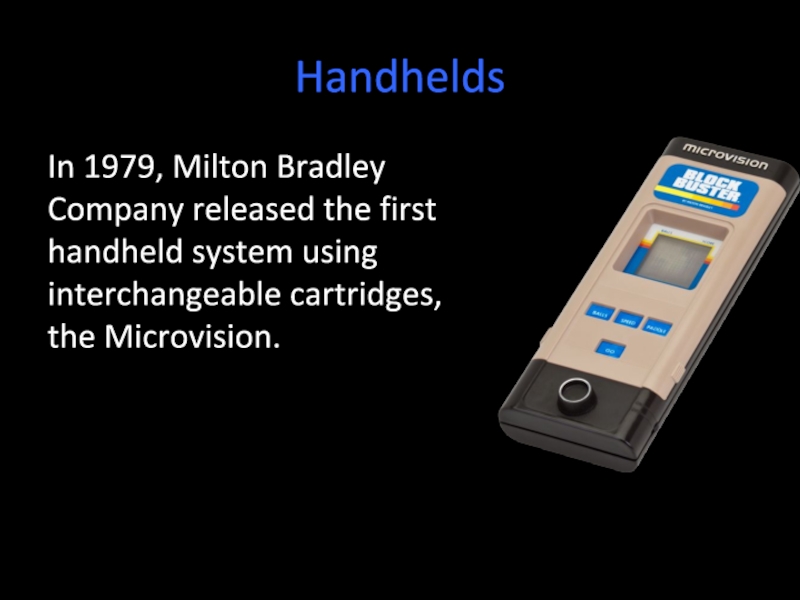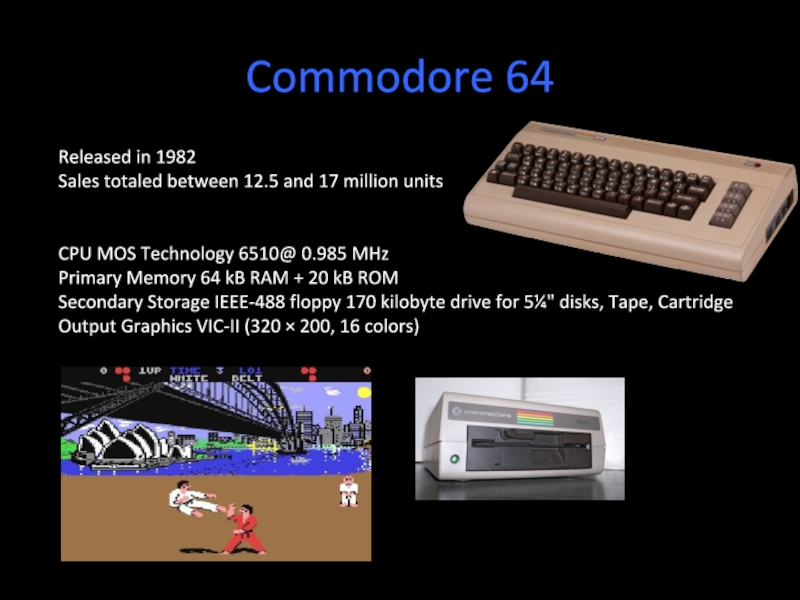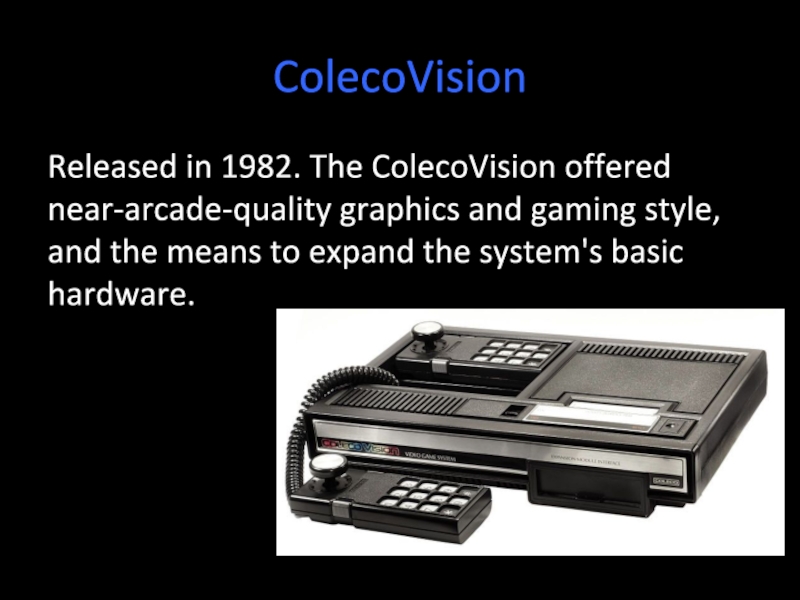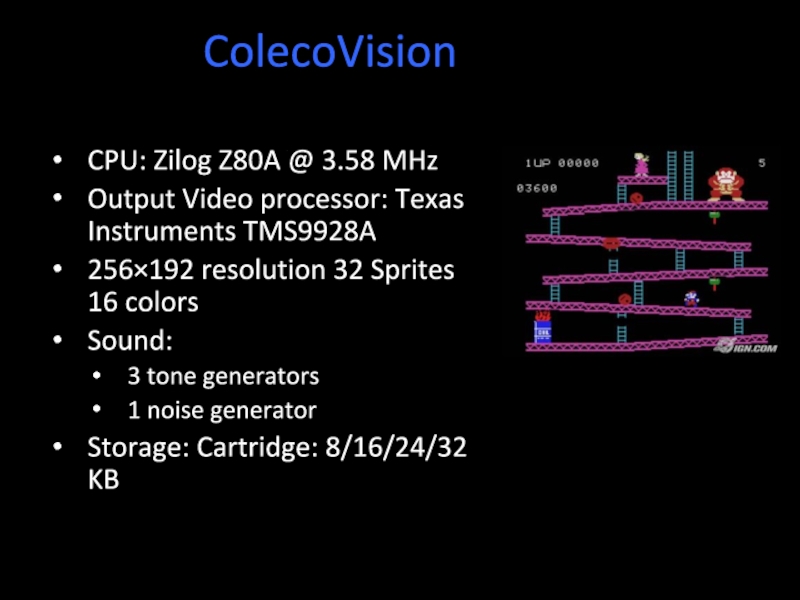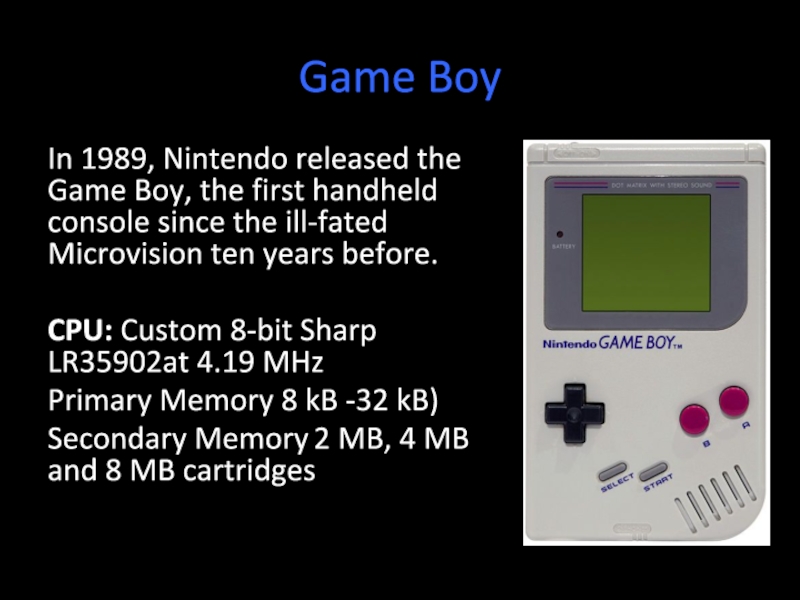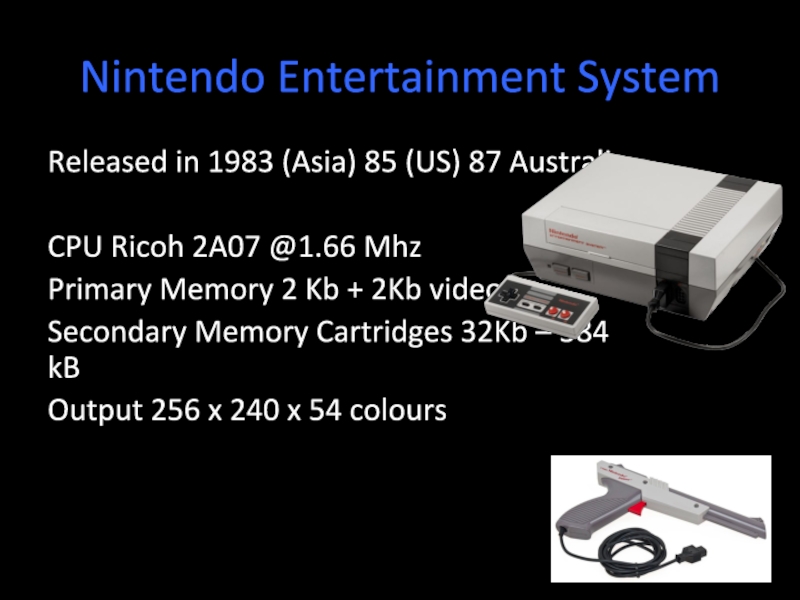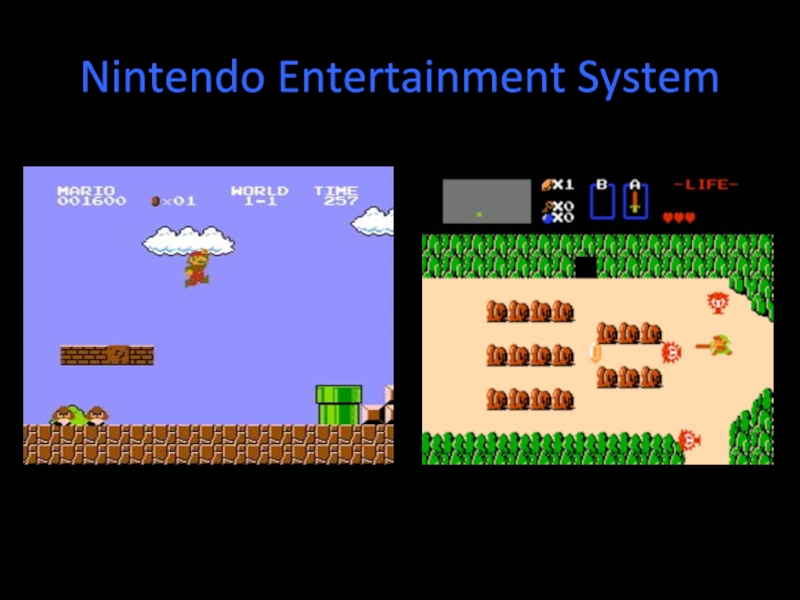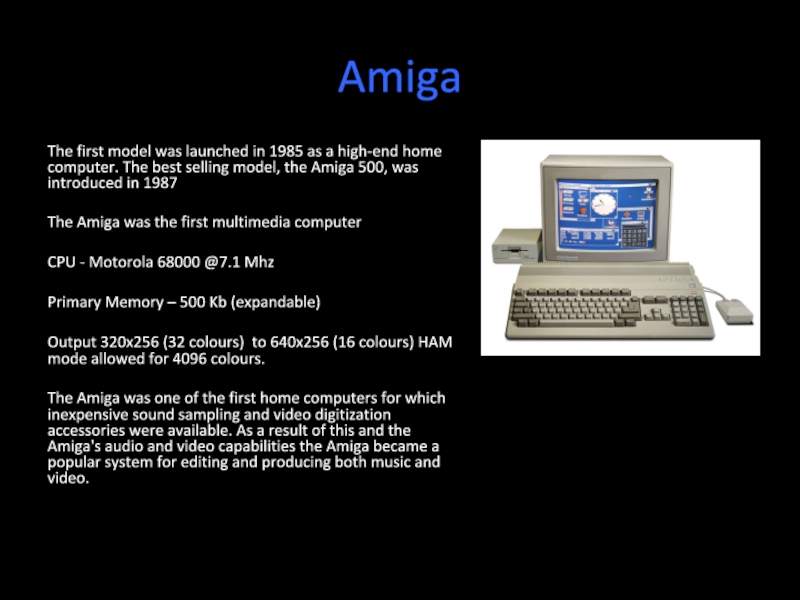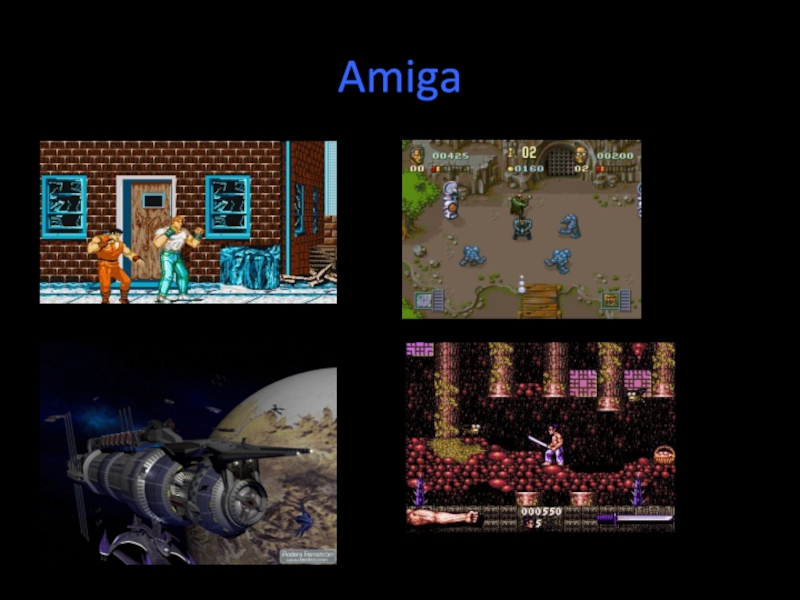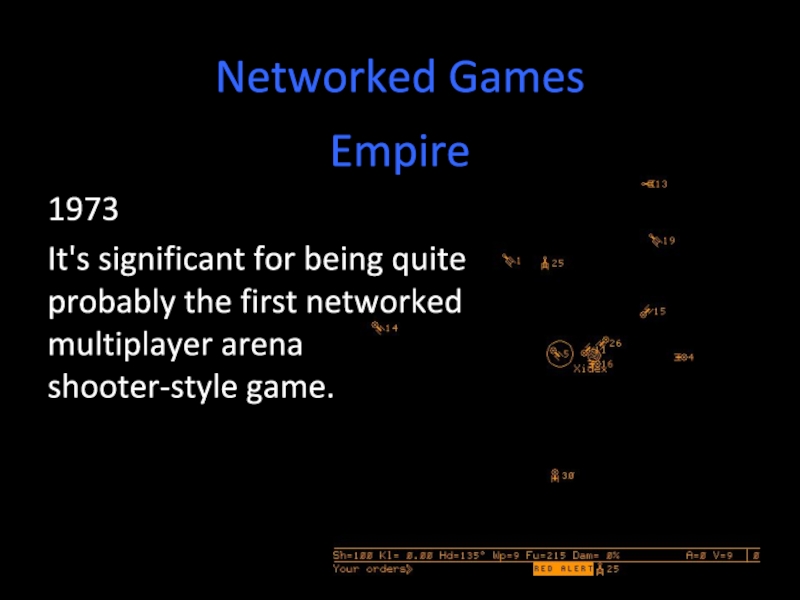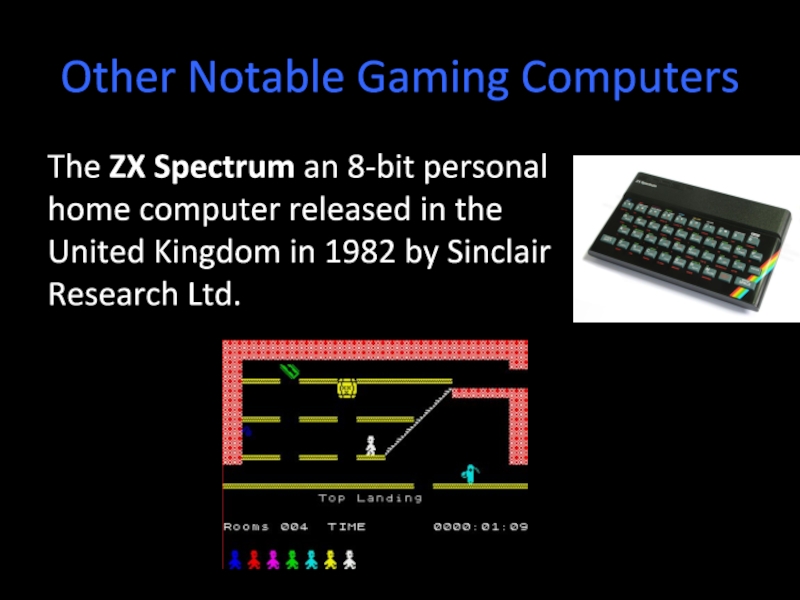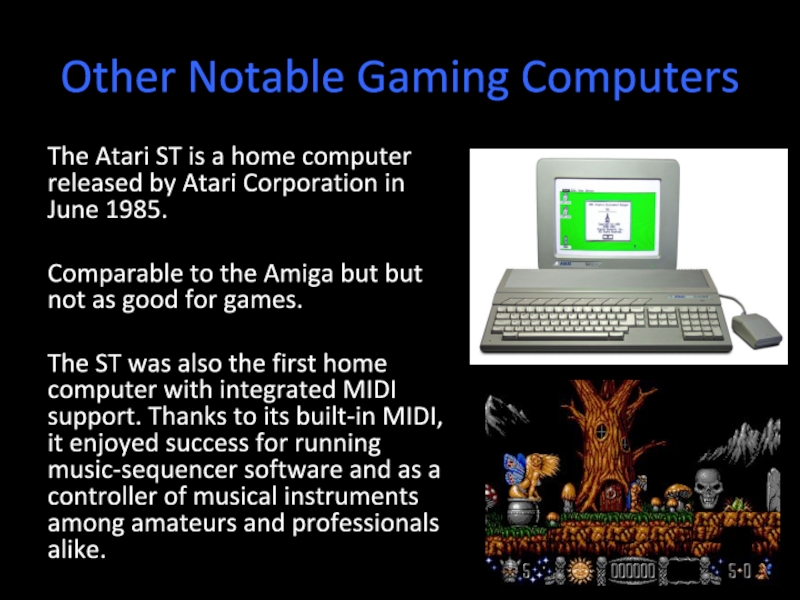- Главная
- Разное
- Дизайн
- Бизнес и предпринимательство
- Аналитика
- Образование
- Развлечения
- Красота и здоровье
- Финансы
- Государство
- Путешествия
- Спорт
- Недвижимость
- Армия
- Графика
- Культурология
- Еда и кулинария
- Лингвистика
- Английский язык
- Астрономия
- Алгебра
- Биология
- География
- Детские презентации
- Информатика
- История
- Литература
- Маркетинг
- Математика
- Медицина
- Менеджмент
- Музыка
- МХК
- Немецкий язык
- ОБЖ
- Обществознание
- Окружающий мир
- Педагогика
- Русский язык
- Технология
- Физика
- Философия
- Химия
- Шаблоны, картинки для презентаций
- Экология
- Экономика
- Юриспруденция
The History Of Video Games презентация
Содержание
- 1. The History Of Video Games
- 2. Tennis for Two was first introduced on
- 3. ANALOGUE COMPUTER
- 4. In 1961, a group of students at
- 5. The PDP-1 had an equivalent to 9,216
- 6. In 1966, Ralph Baer engaged co-worker Bill
- 7. MAGNAVOX ODYSSEY The Magnavox Odyssey is the
- 8. The system was powered by batteries and
- 9. Units sold 330,000 CPU None
- 10. Pong is a two-dimensional sports game that
- 11. In 1974, Atari engineer Harold Lee proposed
- 12. Christmas 1975, Pong was the smashing hit
- 13. Space Invaders Released in 1978, sparking a
- 14. Space Invaders It was one of the
- 15. Fairchild Channel F Released in 1976 at
- 16. Atari 2600 Released in 1977 by Atari,
- 17. Atari 2600 CPU - MOS Technology 6507
- 18. Atari 2600 Controllers
- 19. Atari 2600 Games
- 20. Intellivision Released by Mattel in 1979. Over
- 21. Intellivision Intellivision can be considered the first
- 22. Intelevision CPU - General Instrument CP1610
- 23. Handhelds In 1979, Milton Bradley Company released
- 24. Game and Watch In 1980, Nintendo released
- 25. Commodore VIC-20 Released in 1980. The VIC-20
- 26. Commodore 64 Released in 1982 Sales totaled
- 27. ColecoVision Released in 1982. The ColecoVision offered
- 28. ColecoVision CPU: Zilog Z80A @ 3.58 MHz Output
- 29. Game Boy In 1989, Nintendo released the
- 30. Nintendo Entertainment System Released in 1983 (Asia)
- 31. Nintendo Entertainment System
- 32. Amiga The first model was launched in
- 33. Amiga
- 34. Empire 1973 It's significant for being quite
- 35. Other Notable Gaming Computers The ZX Spectrum
- 36. Other Notable Gaming Computers The Atari ST
Слайд 2Tennis for Two was first introduced on October 18, 1958. Two
TENNIS FOR TWO
Слайд 4In 1961, a group of students at MIT, including Steve Russell,
SPACE WAR
Слайд 5The PDP-1 had an equivalent to 9,216 eight-bit bytes of memory.
The PDP-1 used punched paper tape as its primary storage medium.
PDP-1
Слайд 6In 1966, Ralph Baer engaged co-worker Bill Harrison in the project,
CHASE
Слайд 7MAGNAVOX ODYSSEY
The Magnavox Odyssey is the world's first commercial home video
The Odyssey was designed by Ralph Baer, who began around 1966 and had a working prototype finished by 1968. This prototype, known as the Brown Box
Слайд 8The system was powered by batteries and had no sound capability.
The
The system was sold with translucent plastic overlays that gamers could put on their TV screen to simulate colour graphics, though only two TV sizes were supported.
MAGNAVOX ODYSSEY
Слайд 9Units sold 330,000
CPU None
Controller input Two paddles
The Odyssey was
MAGNAVOX ODYSSEY
Слайд 10Pong is a two-dimensional sports game that simulates table tennis.
Pong was
PONG
Слайд 11In 1974, Atari engineer Harold Lee proposed a home version of
The idea was to concentrate all electronic components of the arcade version into one chip. According to today's standards it's extremely simple: a tennis game on a television screen. But in 1974, the chip needed was the most sophisticated ever used in a consumer product.
HOME PONG
Слайд 12Christmas 1975, Pong was the smashing hit for Sears. In several
Thanks to Pong, Atari in 1975 had a turnover of 40 million dollars.
HOME PONG
Слайд 13Space Invaders
Released in 1978, sparking a renaissance for the video game
It was originally manufactured and sold by Taito in Japan
Слайд 14Space Invaders
It was one of the forerunners of modern video gaming
The game uses an Intel 8080 central processing unit (8-bit - 2Mhz)
Space Invaders grossed US$2 billion worldwide by 1982.
The 1980 Atari 2600 version quadrupled the system's sales and became the first "killer app" for video game consoles.
Слайд 15Fairchild Channel F
Released in 1976 at the retail price of $169.95.
CPU - Fairchild F8 8-bit - 1 MHz-2 MHz
Memory - 64 bytes of system RAM
Output - A resolution of 102 × 58 pixels.(ish)
Input - The controllers are a joystick without a base. It could be used as both a joystick and paddle (twist), and not only pushed down to operate as a fire button but also pulled up.
Слайд 16Atari 2600
Released in 1977 by Atari, Inc. It is credited with
Слайд 17Atari 2600
CPU - MOS Technology 6507 running at 1.19 MHz
Primary Memory
Secondary Memory - ROM (game cartridges): 4 kb maximum capacity (they got this up to 32 kb later)
Input - joysticks, paddles, keyboards, etc.
Output - 160 x 192 pixels, 128 colors were available.
Слайд 20Intellivision
Released by Mattel in 1979. Over two million Intellivision consoles had
Слайд 21Intellivision
Intellivision can be considered the first 16-bit game console.
The Intellivision was
Intellivision was the first console to feature a controller with a directional pad.
Intellivision was also the first console to have a complete built-in character font.
Слайд 22Intelevision
CPU - General Instrument CP1610 16-bit microprocessor. 0.9 MHz)
Primary
Output - 159 pixels wide by 96 pixels high 16 color palette.
Слайд 23Handhelds
In 1979, Milton Bradley Company released the first handheld system using
Слайд 24Game and Watch
In 1980, Nintendo released its Game & Watch line
Different models were manufactured, with some having two screens and a clam-shell design (the Multi Screen Series). The Nintendo DS and Game Boy Advance SP later reused this design.
The modern "cross" D-pad design was developed in 1982 by Yokoi for the Donkey Kong handheld game.
Слайд 25Commodore VIC-20
Released in 1980. The VIC-20 was the first computer of
CPU MOS Technology 6502 @ 1.02 MHz (NTSC)
Primary Memory 5 - 64 kB
Secondary Storage – Tape and Cartridge
Graphics VIC 176 x 184
Слайд 26Commodore 64
Released in 1982
Sales totaled between 12.5 and 17 million units
CPU
Primary Memory 64 kB RAM + 20 kB ROM
Secondary Storage IEEE-488 floppy 170 kilobyte drive for 5¼" disks, Tape, Cartridge
Output Graphics VIC-II (320 × 200, 16 colors)
Слайд 27ColecoVision
Released in 1982. The ColecoVision offered near-arcade-quality graphics and gaming style,
Слайд 28ColecoVision
CPU: Zilog Z80A @ 3.58 MHz
Output Video processor: Texas Instruments TMS9928A
256×192 resolution
Sound:
3 tone generators
1 noise generator
Storage: Cartridge: 8/16/24/32 KB
Слайд 29Game Boy
In 1989, Nintendo released the Game Boy, the first handheld
CPU: Custom 8-bit Sharp LR35902at 4.19 MHz
Primary Memory 8 kB -32 kB)
Secondary Memory 2 MB, 4 MB and 8 MB cartridges
Слайд 30Nintendo Entertainment System
Released in 1983 (Asia) 85 (US) 87 Australia
CPU Ricoh
Primary Memory 2 Kb + 2Kb video
Secondary Memory Cartridges 32Kb – 384 kB
Output 256 x 240 x 54 colours
Слайд 32Amiga
The first model was launched in 1985 as a high-end home
The Amiga was the first multimedia computer
CPU - Motorola 68000 @7.1 Mhz
Primary Memory – 500 Kb (expandable)
Output 320x256 (32 colours) to 640x256 (16 colours) HAM mode allowed for 4096 colours.
The Amiga was one of the first home computers for which inexpensive sound sampling and video digitization accessories were available. As a result of this and the Amiga's audio and video capabilities the Amiga became a popular system for editing and producing both music and video.
Слайд 34Empire
1973
It's significant for being quite probably the first networked multiplayer arena
Networked Games
Слайд 35Other Notable Gaming Computers
The ZX Spectrum an 8-bit personal home computer
Слайд 36Other Notable Gaming Computers
The Atari ST is a home computer released
Comparable to the Amiga but but not as good for games.
The ST was also the first home computer with integrated MIDI support. Thanks to its built-in MIDI, it enjoyed success for running music-sequencer software and as a controller of musical instruments among amateurs and professionals alike.
